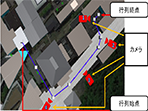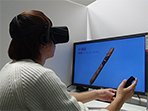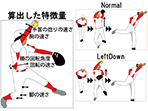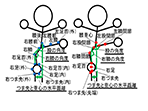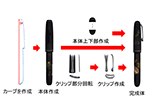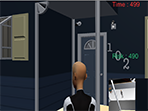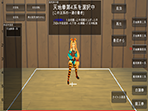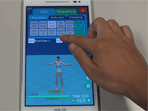| Automatic Synthesizing System of Choreography for Supporting Contemporary Dance Creation |
The purpose of this study is to support the creation of contemporary dance choreography using 3D motion data acquired by motion capture. In this study, I have developed "Body-part Motion Synthesis System" (BMSS) to automatically synthesize short choreography motions by using 3D motion data and to create phrases or sequences by combining them. Furthermore, the system simulates these motions in 3DCG. This system runs on a tablet computer, so it is possible to intuitively control it by touch operation. In automatic generation of short choreography motions, this system synthesizes such motions by replacing body-part motions or by mixing whole-body motion. The generation of unnatural motions is prevented by adjustment of synthetic timing and transition time based on the center of gravity position, the ground state of the feet, arms, or torso, and the difference of pose between before and after synthesizing. In its automatic generation of phrases, this system evaluates connectivity between created or saved short choreography motions using the similarity of pose included in each choreography motion, which is determined by the distance between poses. Based on this, a few choreography motions that contain a pose similar to the pose of the choreographic motion entered by user are connected. In addition, this system randomly selects a connecting motion from within the range of a threshold in order to make variations from the results.To evaluate the automatic synthesizing system of choreography motion, an experiment was conducted with 25 students who study dance in Japan, USA, and UK. From the results of the experiment, the effectiveness of this system for supporting dance creation and understanding of motions was confirmed regardless of country or dance experience. A choreography-creation experiment was also conducted with the participation of four professional choreographers. The results clarify the situations and problems for which the system could work effectively. Next, an experiment was conducted to evaluate the effectiveness of the method of handling phrases. In this experiment, subjects were eight students who study dance choreography at university. The results show that automatically synthesized phrases were effective for creating a new idea of motions and supporting dance training. Consequently, this system's method of automatically synthesizing phrases was confirmed to be effective for supporting dance creation.
- Yuho Yazaki, Asako Soga, Bin Umino, Motoko Hirayama, Automatic Composition by Body-part Motion Synthesis for Supporting Dance Creation, Proc. of International Conference on Cyberworlds 2015, pp.200-203 (Gotland, Sweden), Oct. 2015


